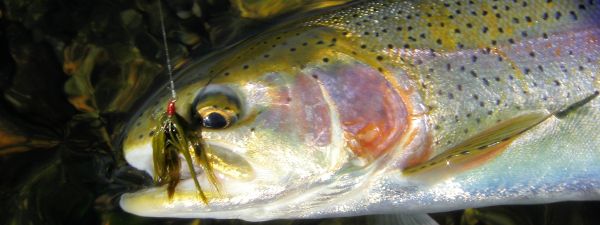
Enjoy mountain fishing in the coastal plains
Winter is the time of year to witness one of nature’s more unusual spectacles here in Louisiana — the Sundog.
The Sundog is an upside-down rainbow. A typical rainbow is caused by light refracting through water droplets in the atmosphere. The Sundog is caused when light refracts through ice crystals.
Your best chance to spot one is after a strong cold front pushes through, when skies are clearing but high-altitude clouds persist.
Just as rare in this state, and also only found in winter, is a rainbow of a different type — rainbow trout. Or as we refer to them, rainbeaux trout.
Oncorhynchus mykiss is a member of the salmonid family, native to North American cold-water rivers, streams and lakes. It’s been transplanted worldwide. Its biology suits it well for artificial propagation. And that’s good because rainbow trout are the second-most-sought after sport fish in the United States after largemouth bass.
What makes rainbows so special?
They have all the qualities you want in a great gamefish. They are streamlined and strong, their bodies mostly muscle to overcome strong currents. When hooked, rainbows can make strong runs and will often jump several times.
They are omnivorous feeders, but at times can be highly selective. They readily take flies, especially on the surface.
They grow fast and get big — very big. The world record is 48 pounds, although any rainbow over 5 pounds is considered a trophy.
And last but not least is their beauty. They seem dressed for Mardi Gras in their iridescent colors of purple, silver, gold and green.
For trout to survive year round, they require water temperatures below 70 degrees. Nearby states like Alabama, Arkansas, Oklahoma and Texas have year-round trout fisheries thanks to tailwater discharges from deep reservoirs. The water that comes from the bottom of a deep lake is cold enough to sustain trout for many miles beyond the dam.
Only one Louisiana reservoir has enough depth for a tailwater trout fishery. That’s Toledo Bend. But given the number of stripers that live below that dam, in a short time you’d have no trout left and lots of fat stripers.
Most states — even those that have cold mountain rivers — have winter stocking programs in community ponds. Louisiana was once one.
In 1990, Dr. Jerry Clark — then assistant director of Fisheries for LDWF — adopted the Urban Fisheries Program from a similar program he had overseen in Texas. Several small lakes across the state were stocked with rainbows beginning in late December. To help offset the program’s cost, a low-fee trout stamp was implemented.
When Clark left for another position elsewhere, the program was abandoned.
Six years ago, East Baton Rouge Parish Parks and Recreation (BREC) decided to reactivate the program on a local basis. They stocked four of their 11 park lakes. The program turned out to be so popular that it has continued ever since.
Other parishes are taking notice. Ascension Parish is stocking trout this winter in their pond at Lamar-Dixon.
For now, if you want to catch Louisiana’s rainbeaux trout, you’ll need to head to the Capitol City area.
The limit is four fish per day, but I strongly urge everyone to release their fish for now. Trout fresh from the hatchery tastes like dog food. And not the good kind either (don’t ask how I know what dog food tastes like).
It takes a few weeks for the flesh to become tasty.
During that time the trout get acclimated to natural foods — including hatching aquatic insects.
While black or olive woolybuggers will catch most of the fish in early January, by the end of the month you’ll see them constantly rising to insects.
There’s no shortage of mosquitoes in our waters, and trout can actually get fat eating enough of them. A few mayflies show up in early February, as do hordes of craneflies. That’s when fly anglers can enjoy great late-afternoon action on the ponds — provided enough trout are left.
As for tackle, a 5-weight outfit with weight-forward floating line works as well for trout as it does for bream, crappie and smaller bass. For more fun, try a lighter outfit like a 3-weight. There’s nothing like catching a nice rainbeaux on an ultralight fly rod.
How long can the trout survive? The latest I’ve ever caught one was the last week of March. However, there is a possibility that in the near future we might have a trout than can live in our waters into May. Researchers are studying two strains of trout that have higher warm-water tolerance: rainbows from the Firehole River in Wyoming and the Redband trout native to some desert areas.
I hope that someday the trout-stocking program will go statewide once again. If our public officials could see what I see — kids, teenagers and families enjoying the outdoors and the thrill of catching fish off the bank — they would agree.


